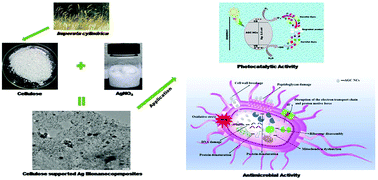Evaluation of the multifunctional activity of silver bionanocomposites in environmental remediation and inhibition of the growth of multidrug-resistant pathogens†
Abstract
Synthesis of bio-based environmental remedial and antimicrobial products is an urgent need of the 21st century in the COVID-19 pandemic world. Keeping this in mind, cellulose-supported Ag bionanocomposites (AGC NCs) were synthesized by using cellulose as a reducing and stabilizing agent. AGC NCs showed potential antimicrobial activity against Candida albicans, Escherichia coli, Staphylococcus aureus, Klebsiella pneumoniae, and Bacillus subtilis with a MIC of 15, 15, 35, 15, and 30 μg ml−1 respectively. AGC NCs efficiently degraded harmful dyes, Orange G, Phenol red, Brilliant blue FCF, Giemsa stain, Neutral red, and 2-nitro aniline in the presence of sunlight with a rate constant of 0.229 × 10−2 min−1, 1.147 × 10−2 L mol−1 min−1, 0.447 × 10−2 L mol−1 min−1, 4.144 × 10−2 mol L−1 min−1, 0.317 × 10−2 L mol−1 min−1, and 0.785 × 10−2 L mol−1 min−1 in 60 min respectively. AGC NCs also showed efficient antioxidant activity in DPPH assay with an IC50 value of 52.67 μg ml−1. Formation of Ag NPs was confirmed by observing the UV-Visible absorption peak at 418 nm. The FCC structure of AGC NCs was confirmed by the X-ray diffraction (XRD) pattern with well-defined peaks at angles 38.24°, 44.40°, 64.64°, and 77.28° corresponding to the planes 111, 200, 220, and 311, with a d-spacing of 2.35, 2.04, 1.44, and 1.23 (JCPDS no. 00-001-1164). The presence of cellulose in AGC NCs was determined by Fourier transform infrared spectroscopy (FTIR) with bands at 3421.90 cm−1 and 2899.3 cm−1 due to O–H stretching and the methylene (–CH2–) group respectively and at 1076–1023 cm−1 and 903 cm−1 due to –C–O–C– pyranose ring skeletal vibration and β-glycosidic linkages. The morphology, shape and size (13.21 nm), and elemental composition of the nanocomposites were determined by scanning electron microscopy (SEM), transmission electron microscopy (TEM), and energy dispersive spectroscopy (EDS) respectively. The thermal properties (exothermic peaks appear at 335 °C and 440 °C due to the thermal degradation of Ag NPs and cellulose respectively), surface area (13.892 m2 g−1), stability (−18.43 ± 0.850 mV), and hydrodynamic diameter (399.10 ± 30.49 nm) and polydispersity index (PDI) value (0.565 ± 0.193) of the composites were determined by thermogravimetric analysis (TGA) and differential thermal analysis (DTA), Brunauer–Emmett–Teller (BET) method, Zeta potential studies, and dynamic light scattering (DLS) respectively.



 Please wait while we load your content...
Please wait while we load your content...